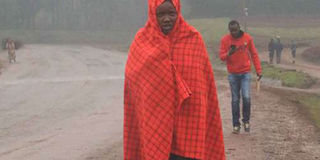Cold weather highlights health challenges counties must tackle

A resident of Wamagana village in Tetu shield herself from cold on June 28, 2016. Cold weather at this time of the year is not ideal for food crops such as maize, which requires weeks of sunshine to dry. PHOTO | JOSEPH KANYI | NATION MEDIA GROUP
What you need to know:
- Cold weather generally heralds a sharp increase in respiratory diseases, some of which can be fatal if left untreated.
- In a country where agriculture is solely dependent on the availability of rain, this should be cause for concern because it is likely to lead to an increase in food prices.
My Standard One classroom was an open pit in a school not too far from the Lanet military barracks in Nakuru.
Throughout that year, I believed that my school had the coldest mornings in the whole world.
I was disabused of this notion a few years later when I visited one of my relatives in Kinangop. Back in the day, Kinangop was nothing but ranges, forests, and pyrethrum estates.
There, the cold did not just happen. It came in herds, like the elephants from the Aberdare Forest next door.
Decades later, my father would tell me that when he was a pupil in Lari, it would take about six hours for pain to register after he and his peers were caned for lateness.
All too often, pupils would start wailing in the middle of a lesson, at around midday, when the sun peeped from behind the fog and its warmth drove the numbness from the palms of their hands.
Over the years, Kenyans have come to expect that it will generally be cold in June. Once in a while, the cold spell spills over into July. Nothing unusual there.
This year, however, August joined the coalition of the cold and some of us in Nairobi started wondering whether the low temperatures had been entrenched in the Constitution while we were busy fighting corruption.
When the first week of September arrived and there was no indication that the sun was making its way to the equinox, some of us started getting worried.
We even started buying brown leather jackets. Warmth, after all, begins with you.
Indeed, there is a direct relationship between weather conditions and health, especially for the very young and the elderly.
Cold weather generally heralds a sharp increase in respiratory diseases, some of which can be fatal if left untreated.
Therefore, if the low temperatures persist for three more months, as the Meteorological Department has warned, this will have far-reaching implications on public health because it will increase the risk of illness among the vulnerable groups, especially in rural areas, where health services remain deplorable.
HEALTH HAZARDS
There is, therefore, an urgent need for county governments and health experts to map out the regions likely to be hardest hit by the adverse weather and supply the drugs that are likely to be most needed.
The Meteorological Department has also warned that between October and December, some regions will experience “generally depressed rainfall that will be mainly driven by the evolving La Niña conditions”.
In a country where agriculture is solely dependent on the availability of rain, this should be cause for concern because it is likely to lead to an increase in food prices.
Cold weather at this time of the year is not ideal for food crops such as maize, which requires weeks of sunshine to dry.
A prolonged cold spell, therefore, could reduce harvest. There is also the attendant risk of the cereal getting affected by aflatoxin.
Generally, low harvests affect poor families the most because, first, their income is low and second, much of the money they earn is spent on food and medicine.
What this means is that in the coming months, the poor will not have enough to eat and, as a result, will be at greater risk of contracting diseases.
Their food and medical bills are likely to go up, raising their cost of living.
A report released on Wednesday by the Kenya Medical Research Institute indicates that 36 per cent of pregnant women in Nairobi suffer from iron deficiency, 53 per cent have vitamin D deficiency, while another 21 per cent have a combination of nutritional deficiencies.
There are not many ways to get vitamin D apart from the intervention of the sun.
WAY FORWARD
There is a real risk that these women, who are malnourished already, will give birth to underweight babies.
By this single “accident of birth”, these babies will be born disadvantaged at the height of cold weather.
That women in the capital — which is richer than many of the other 46 counties — are not having enough to eat is in itself an ominous sign and a pointer to the public health gaps that continue to plague our country.
This worrying scenario is made worse by adverse weather.
So, even as those with a disposable income rush for warm “leta chagets”, let us remember that diet is an important weapon in combating the cold because it provides the nutrients that keep diseases at bay.
Mr Mbugua is the deputy managing editor of the Daily Nation. [email protected]





